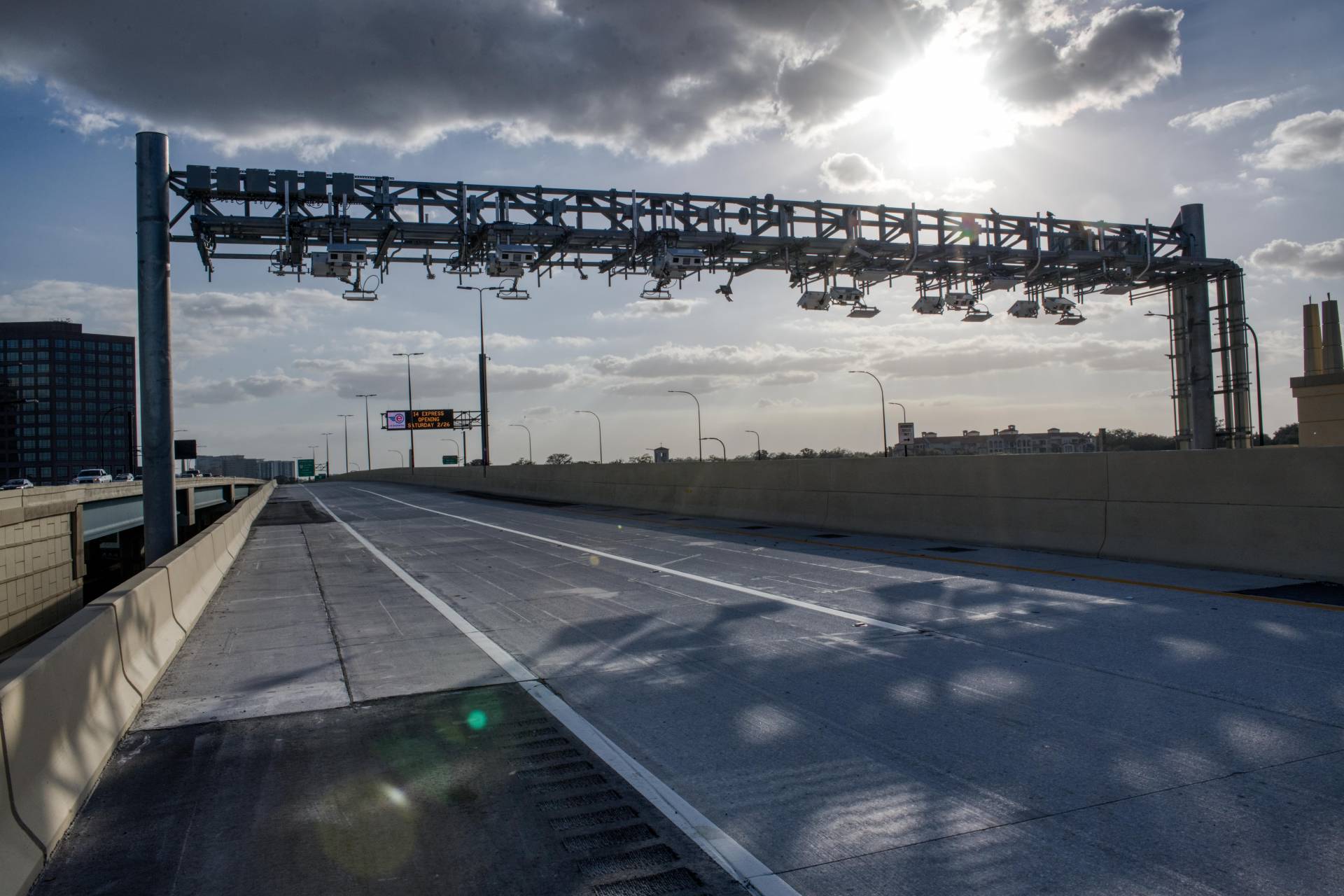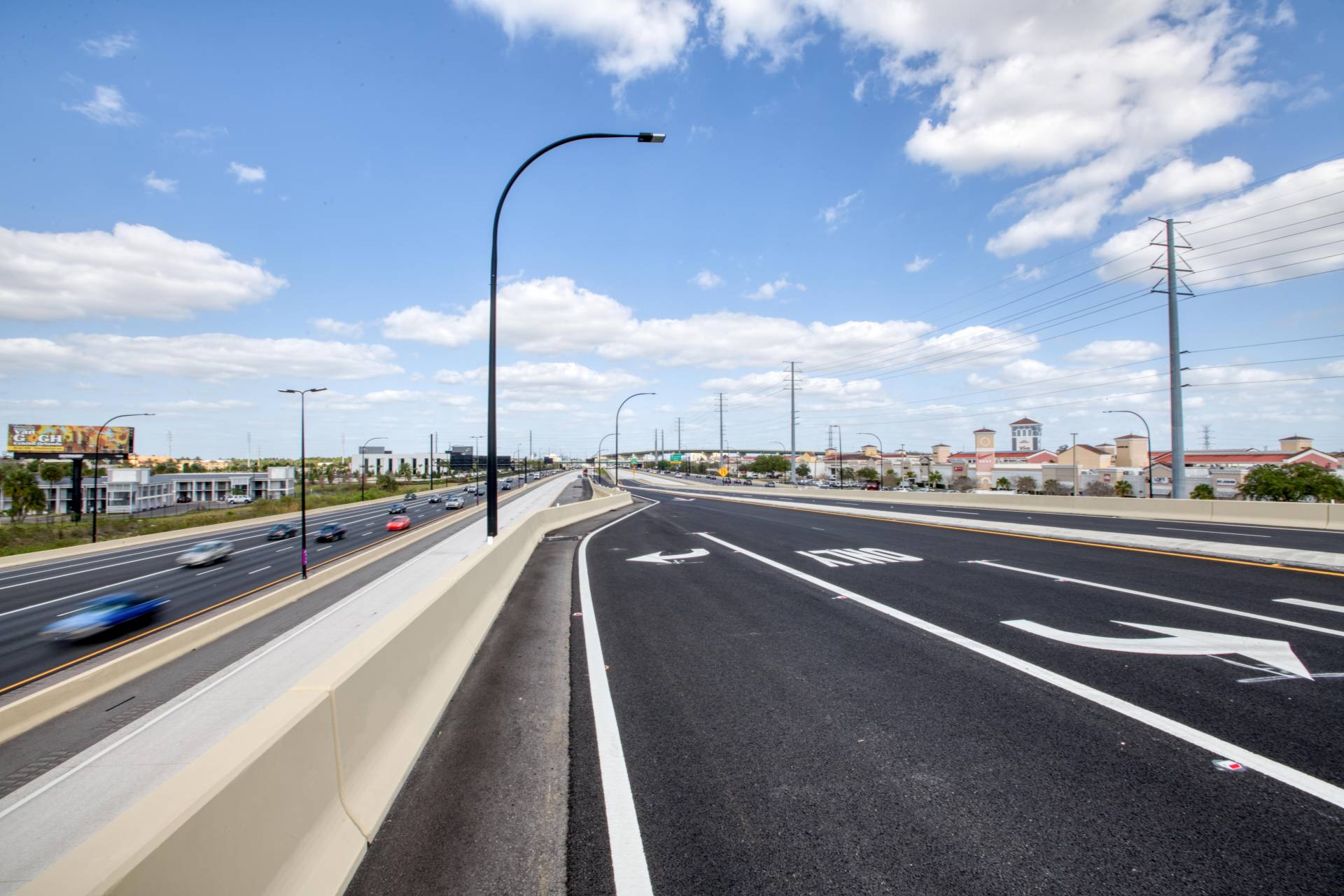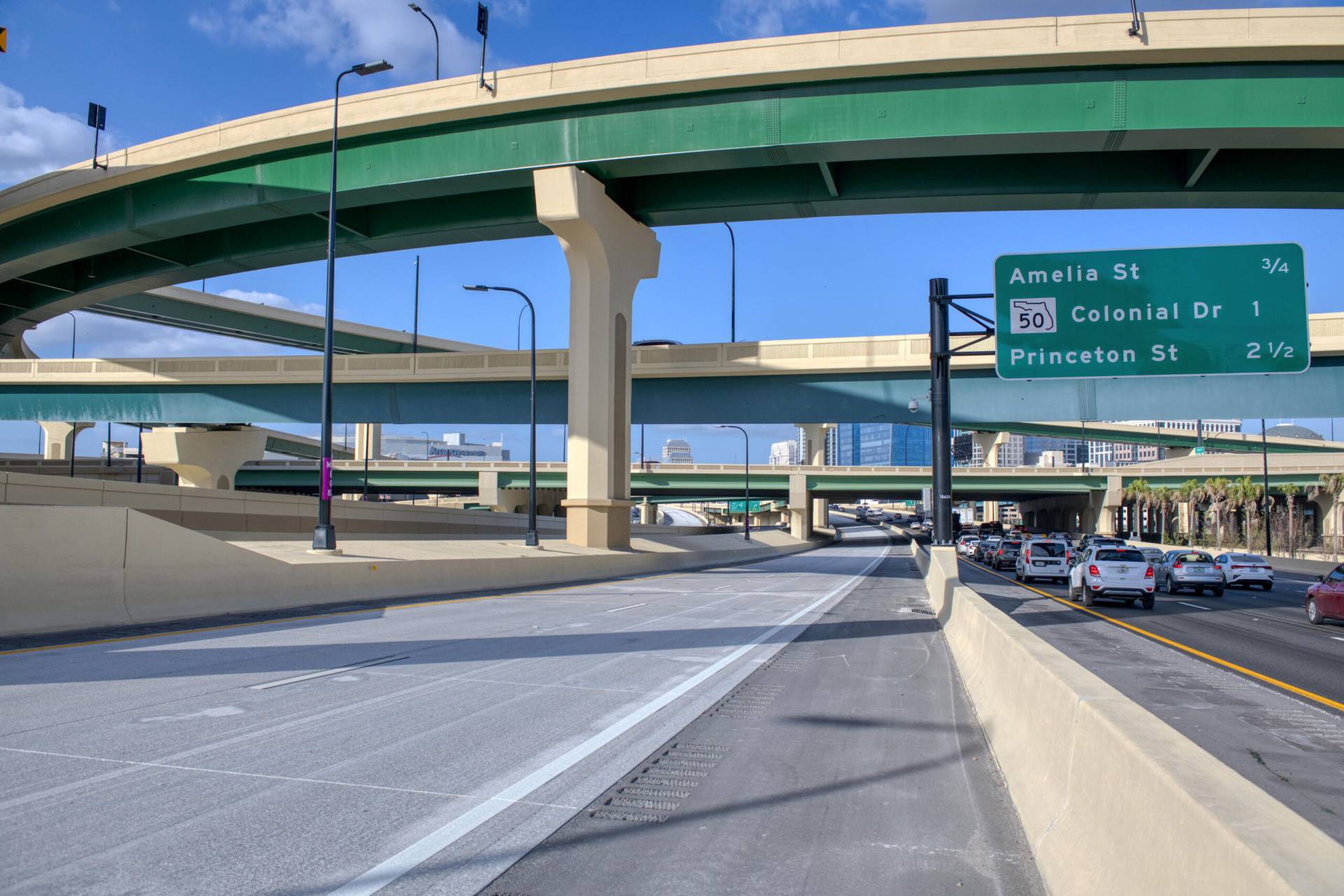The landmark I-4 Ultimate, Florida Department of Transportation’s largest-ever infrastructure project, ushers in a new era of mobility, safety and access in fast-growing Central Florida.
DESIGNER
2023
The I-4 Ultimate project is now a world-class infrastructure facility that is transforming Central Florida’s transportation landscape.
The Florida Department of Transportation began planning the buildout of I-4, the region’s main thoroughfare and busiest highway, in the 1980s. A public-private partnership concession agreement, signed in 2014, kicked off the project in earnest. FDOT chose HNTB to provide construction oversight, a role that included managing the P3 agreement throughout the construction period.
Supported by more than a dozen local, state and federal agency representatives, FDOT broke ground on the massive, $2.3 billion I-4 Ultimate project in February 2015. The largest infrastructure project in the state’s history, the project aimed to remake every inch of pavement on the 21-mile corridor, widening it and adding capacity and congestion relief with four new express lanes – two in each direction – within the center right-of-way.
“I-4 at the time largely was comprised of the original interchanges and horizontal and vertical alignments from when it was first constructed,” said John Tyler, FDOT District 5 secretary. “The infrastructure needed to be rebuilt to current standards to handle the region’s present and future traffic growth. FDOT was committed to improving safety and mobility on this vital highway.”
Originally, the I-4 Ultimate project was envisioned as a series of smaller jobs that would have been conventionally funded through transportation taxes and legislative processes – an approach that could have stretched construction up to 27 years.
“To deliver the project in about seven-and-a-half years, as FDOT has done, was a monumental achievement by the agency and the P3 team,” said Mike Gwynne, HNTB construction oversight services resident engineer. “The Project stakeholders, which includes several water-management districts and nine city and county jurisdictions across the 21 miles, began partnering with FDOT 20 years before a shovel was put in the ground, and continued that partnership working collaboratively with the FDOT and P3 team throughout construction.”
“The success of I-4 Ultimate relied on these entities coming together cooperatively to support FDOT’s construction. Once they had reached agreements on interchange alignments and what the right-of-way agreements would be., the cities entrusted FDOT with their streets and the impacts to their communities to deliver this program,” said Gwynne.
Project Facts:
- $2.3B budget
- Public Private Partnership project
- Widening 21-mile corridor
- Increasing corridor speeds from 50 mph to 60 mph
- Added 4 new express lanes
- 15 major interchanges reconstructed
- 150 bridges replaced or widened
- 248 miles of piling driven
- 70 miles of drainage pipe installed
- 38 million square feet of MSE Wall constructed
- More than 1 million tons of asphalt placed
- 9 city and county jurisdictions
- 10 miles of sidewalks
- 5 miles of bike lanes
A jewel in downtown Orlando’s crown
Most of I-4 Ultimate’s lane miles lie within Orlando city limits. The interstate runs through the heart of downtown, where work on the important I-4/State Road 408 interchange began shortly after project construction commenced.
Throughout the project area, numerous major crossroads intersect the interstate. Of the 15 major interchanges completely reconstructed as part of the project, I-4/S.R. 408 was the most complex.
Orlando has grown around I-4 since the roadway was constructed in the 1950s and 1960s. Amway Center, home to the NBA’s Orlando Magic, stands at one corner of the I-4/S.R. 408 interchange; City Hall stands at another. On the other two sides, residential communities were built up to the right-of-way limits. Utility lines are pervasive, and an Orlando Utilities Commission substation that supplies downtown power is located nearby.
These constraints left the project team little space to maneuver, necessitating new ramps from surface streets onto S.R. 408 be built several stories higher than the previous ramps had been. Travel lanes, too, had to be constructed at higher elevations over the existing lanes while simultaneously building capacity outward horizontally.
To streamline traffic for the 200,000 drivers who navigate through downtown Orlando each day, travel lanes and bridge and ramp movements remained open during peak travel times, with closures limited mostly to overnight hours. A complicated set of temporary bridges over Church and South Streets was constructed to keep interstate traffic moving while the construction team removed the old eastbound I-4 lanes and built new ones.
When COVID-19 struck in early 2020, FDOT recognized that shutdown impacts presented the team with the ability to accelerate key projects, including the I-4/S.R. 408 downtown interchange.
“I-4 Ultimate was viewed as an economic driver to help the state recover from the effects of COVID-19,” Gwynne said. “Gov. DeSantis asked FDOT to consider how the project could benefit from traffic volumes that were down 30% or more.”
“FDOT clarified our level of willingness to be aggressive and challenged HNTB to present the contractor with options that would accelerate construction,” Tyler said. “Among the steps the contractor took were more lane and ramp closures for longer periods during the daytime hours. To finish work on the I-4/S.R. 408 interchange, the contractor took the westbound I-4 mainline to a single lane for a week — an action that wouldn’t have been possible without the dramatic reduction in traffic congestion during the pandemic.”
The I-4/S.R. 408 interchange opened to traffic in summer 2020 — six months ahead of schedule because of the COVID-related project acceleration — as a four-level structure with sweeping flyover ramps soaring as high as 120 feet above the ground. Conceived in cooperation with S.R. 408’s owner, Central Florida Expressway Authority, and considered the crown jewel of the I-4 Ultimate project, the interchange modernized connections between Central Florida’s two busiest highways, reducing travel times and transforming Orlando’s skyline.
“The success of I-4 Ultimate relied on these entities coming together cooperatively to support FDOT’s construction. Once they had reached agreements on interchange alignments and what the right-of-way agreements would be., the cities entrusted FDOT with their streets and the impacts to their communities to deliver this program,” said Gwynne.
“The success of I-4 Ultimate relied on these entities coming together cooperatively to support FDOT’s construction. Once they had reached agreements on interchange alignments and what the right-of-way agreements would be., the cities entrusted FDOT with their streets and the impacts to their communities to deliver this program,” said Gwynne.




“The success of I-4 Ultimate relied on [the cities and counties] coming together cooperatively to support FDOT’s construction. The cities entrusted FDOT with their streets and the impacts to their communities to deliver this program.”
HNTB Construction Oversight Services Resident Engineer
“HNTB’s team brought FDOT and the state some of the best bridge and roadway inspectors, engineers and schedule expertise available on the market.”
Florida Department of Transportation District 5 Secretary
The construction oversight advantage
I-4 Ultimate was partially funded with federal dollars. Its model allowed for the concessionaire team, which included a design-build contractor and a sampling, testing and inspection consultant, to inspect and accept its own work.
A project-specific agreement enabled the delivery model to proceed, with the stipulation that FDOT, as project owner, would have construction oversight services to ensure quality acceptance processes complied with the contract documents.
In its COS role, HNTB administered the exceptionally complex P3 agreement. Besides monitoring construction quality, stringent performance measures in the contract called for auditing the day-to-day operations of the concessionaire, its contractors and its consultants to make sure contractual standards for traffic flow, accident clearing, hurricane response and other operational requirements were met.
To carry out this unique assignment efficiently and with as little disruption to the concessionaire team as possible, HNTB developed a cutting-edge, risk-based audit tool (RBAP) in cooperation with FDOT.
RBAP’s requirements verification database — a collection of requirements extracted from the agreement – form individual, auditable ‘data points’ that can be updated in minutes. HNTB also built frequency-driven and ad hoc inspection capabilities into the system. RBAP includes a web-based platform that facilitates scheduling audits, audit workflows and communicating with the concessionaire to resolve any noted material failures, construction deficiencies or other issues. The system was used for auditing Construction, Operations and Maintenance, and Federal Compliance oversight.
Beyond contract oversight and helping the concessionaire come up with solutions, to get the work done and keep the public moving and safe, the non-traditional COS role involved coordinating construction activities, including lane closures and detours with the nine jurisdictions across the project length. HNTB also worked closely with FDOT’s public information consultant to distill information and engineering drawings into concepts the public could easily absorb.
“The many facets of the job required a detailed eye for both coordination and management to ensure what was committed to was delivered,” Gwynne said.
“HNTB’s team brought FDOT and the state some of the best bridge and roadway inspectors, engineers and schedule expertise available on the market,” Tyler said. “They already had local experience with project stakeholders, including the City of Orlando and the Central Florida Expressway Authority. Value-added ideas HNTB proposed to the concessionaire helped us complete the project more quickly and efficiently. They were tremendously valuable.”
The benefits of Central Florida’s I-4 Ultimate project extend far beyond the signature corridor itself. Motorists now experience an I-4 with greatly improved safety, connectivity and mobility, with some peak-hour travel times reduced up to 20 minutes. This vital enhancement supports the region’s economy and the quality of life for residents and visitors alike well into the future.
Watch Mike Gwynne, HNTB construction oversight services resident engineer, share more about the impacts of the landmark I-4 Ultimate project. Click here.
Historic preservation and aesthetics
Besides creating a signature corridor that improves safety and enhances the transportation of people and goods, FDOT sought to connect communities and highlight Central Florida’s rich history. Where the original I-4 design created physical barriers in historic neighborhoods within the project footprint, the I-4 Ultimate redesign relocated ramps and bridges to restore physical cohesiveness.
More than 140 customized medallions, representing each city and county in the project corridor, are located at interchanges, overpasses and underpasses. Cities and counties worked with the I-4 Ultimate team to design their logos. Eatonville’s colorful medallion, emblazoned with the words, “The Town That Freedom Built,” recognizes the city’s position as the first incorporated African-American municipality in the U.S.
Beyond concrete and asphalt, FDOT focused on enhancing quality of life and enriching residents’ and visitors’ cultural experiences with aesthetics and landscaping. Bridge supports throughout the improved corridor feature foliage planters and decorative architecture. Most of the project’s bridges feature under-deck lighting; LED lights illuminate the roadway and landscape lighting draws attention to diverse, native plantings. Beautiful water features were installed throughout the corridor.
As part of the I-4 Ultimate project, more than 10 miles of sidewalks and 5 miles of bike lanes were added or widened. Other improvements include new pedestrian bridges in three locations and a new pedestrian tunnel under S.R. 436.
An art endowment program, which set aside $1.5 million in the concessionaire’s initiative, funded permanent art installations throughout the I-4 Ultimate project area.
CONTACT
Mike Gwynne, PE
HNTB Construction Oversight Services Resident Engineer
(321) 228 4397
SEE MORE ARTICLES
MORE DESIGNER STORIES
Dallas Love Field
Fish Passage
Orange Line BRT
KC Levees Program
US 281
